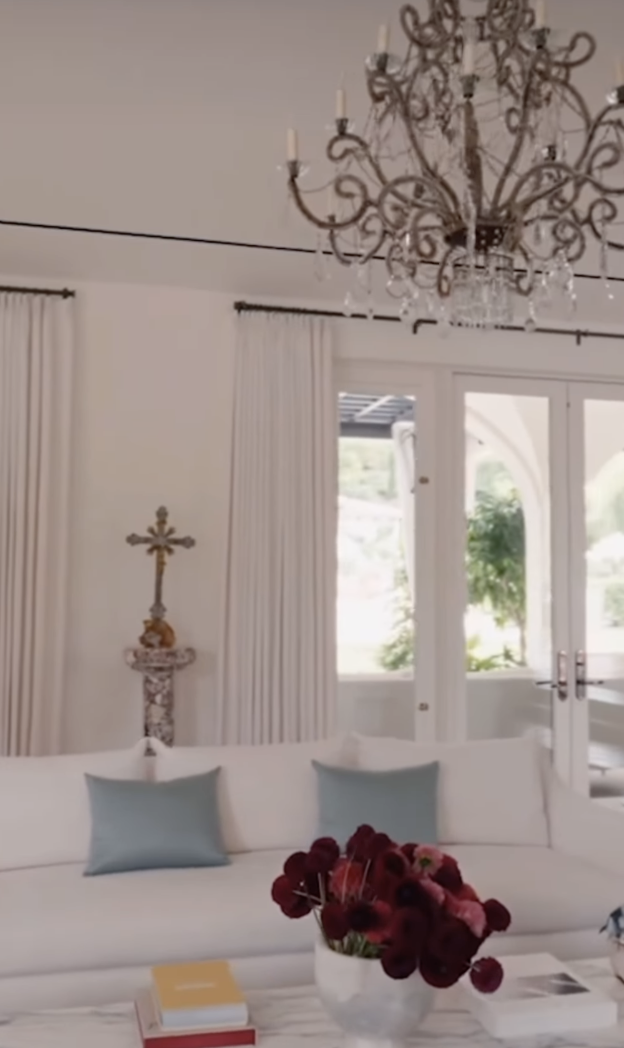Sacred Style: Weaving the Divine into Interiors
Igreja do Carmo, an 18th-century Catholic church in Porto, Portugal, known for its ornate façade and azulejo tilework.
I am currently in Portugal, where I have visited numerous beautiful, stunning, architectural marvels, Catholic churches. This has given me so much inspiration when it comes to interiors. I am originally from Australia, and growing up here, I was not surrounded by religion or had the beautiful churches that provide community, purpose, faith. Seeing these churches has given me so much inspiration and inspires me to incorporate relious inspiration into my home. I think that even if you are not a religious affiliated person, you can still take inspiration from the church. In the quietly powerful world of interiors, there is a growing desire to reconnect with heritage, meaning, and the sacred. But for a new generation of aesthetes, spirituality need not come at the expense of style. In fact, it is being reimagined in ways that feel deeply personal and unapologetically glamorous. At the intersection of faith and fashion lies an emerging interiors narrative: incorporating religious symbolism, motifs, and architecture into the home — but elevated, directional, and resonant.
This is not about doctrine or dogma. Rather, it is a celebration of the craftsmanship, iconography, and grandeur that religious spaces have gifted us for centuries. It is about inviting a sense of reverence and rootedness into our lives, through a high-fashion lens.
Here are some inspiration for ways the catholic church inspires architecture and interiors and how it can extend into your home.
Taking Inspiration from the Catholic Church
Arches, for example, are more than decorative curves — they hold weight, both literal and emotional. Studies in architectural psychology suggest that curved forms, such as arches, are subconsciously processed by the brain as more comforting and pleasing than rigid, rectilinear shapes. Unlike the flat planes of brutalist or totalitarian structures, arches speak in a softer tongue. They invite movement. They lift the gaze. They echo the natural curves of the human body and the earth’s topography. In interiors, even a modest arched doorway or alcove can shift the energy of a room from functional to reflective.
Columns, too, have long served as structural punctuation in sacred spaces. In cathedrals, they create rhythm and procession. In the home, a single salvaged column base or fluted pedestal becomes a sculptural anchor—a nod to grandeur without grandiosity. These vertical elements suggest permanence and order, but when weathered or reinterpreted, they also offer a quiet, architectural humility.
Ceiling height is another inherited gesture of the sacred. In Catholic architecture, the soaring vaults of churches were designed to evoke awe, to create verticality that felt closer to the heavens. While most domestic ceilings cannot compete in scale, the principle still applies: a room with generous height invites openness, breath, and light. Even the suggestion of height—through slim vertical lines, tall mirrors, or elevated moulding—can bring the eye upward, and with it, the spirit.
Tiles, particularly those echoing Mediterranean or Moorish influence, speak to the sacred in repetition. In many churches, the floor is not just something to walk on but a surface for pattern, narrative, and geometry. Encaustic tiles, hand-painted ceramics, or antique terracotta underfoot lend both history and haptics. They ground the body in something storied.
Murals — especially those painted directly onto plaster — evoke the tradition of sacred storytelling. From frescoed chapels to humble domestic altars, wall paintings were used to surround daily life with meaning. In the modern home, a scenic mural on one wall becomes not just a backdrop, but an atmosphere. Whether classical, pastoral, or abstract, these painted surfaces create immersion — a moodscape rather than mere decoration.
Lighting in Catholic spaces was never incidental. It was theatrical, symbolic, choreographed. Light filtered through stained glass did not just illuminate; it coloured emotion. Candlelight flickering on gold-gilded altars turned the ephemeral into the eternal. In today’s homes, the same ethos applies: layered lighting that is warm, diffused, and slow. An antique lamp. A single pendant. A wall sconce casting soft shadows on carved paneling. Natural light, too, when invited with restraint, becomes part of the spiritual register of a room.
Wall panelling — often overlooked — holds deep roots in ecclesiastical interiors. Richly carved wainscoting, confessional booths, velvet-lined chambers: these were all forms of visual and acoustic insulation from the distractions of the outside world. In a home, panelled walls provide quietude and architectural texture. They cocoon. They absorb sound. They bring gravity.
Together, these architectural gestures — arches, columns, ceiling height, murals, tiles, layered lighting, panelled enclosures — whisper of sacred space without declaring it. They are not necessarily religious, but they carry the residue of reverence. They slow the room down. They create a kind of hush.
To incorporate them is not to recreate a chapel, but to remember that the spaces we inhabit can also elevate us. That beauty can have weight. That a room can be not just styled, but sanctified.
Taking Inspiration from faith and high-fashion
High fashion has long turned to religion for inspiration — not in doctrine, but in drama. The Met Gala’s 2018 “Heavenly Bodies” theme made this explicit: golden crowns, embroidered capes, jewelled crosses — all drawing from the rich theatricality of Catholicism. Designers like Dolce & Gabbana and Christian Lacroix have, for decades, explored this intersection, layering velvet, lace, iconography and liturgical silhouettes into couture that feels both exalted and intimate.
Dolce & Gabbana 2013
Sacred Touches: Religious Accessories as Objects of Atmosphere
Candles are perhaps the most enduring. In Catholic tradition, a candle is not just light — it is intention made visible. The glow of a votive offers more than ambience; it’s presence. Whether placed beside a statue, on a tray near the bed, or flickering quietly during dinner, the act of lighting a candle becomes a moment of slowness, of reverence. In interiors, antique candleholders — whether brass altar sticks or simple wax-dripped sconces — add a romantic gravity, grounding even the most contemporary spaces.
Incense has long served as the scent of sanctity. In Catholic tradition, it was not simply aromatic — it was symbolic. Carried in a thurible, like the one pictured above, swung in rhythm by the priest, incense became a visual and olfactory prayer. The rising smoke represented supplication — the soul’s ascent, the invisible made visible. The ritual dates back to early Christian liturgy and even earlier, with roots in Judaic temple practices and Roman ceremonial rites.
Today, these traditions re-enter the domestic sphere not through obligation, but through atmosphere. The scent of frankincense or myrrh is no longer confined to chapels; it finds its place in the home, trailing through hallways, curling in corners. Science supports what ancient worshippers understood intuitively: these resins activate parts of the brain associated with calm and emotional regulation. But beyond neurology, incense reminds us to pause. To breathe.
A carved incense boat resting on a mantle or an antique thurible displayed as sculpture isn’t merely decorative — it’s a relic of ritual. Of scent and ceremony. A way of weaving the sacred into the sensual, every day.
The rosary is both symbol and story. Worn smooth from touch, it carries the imprint of repetition, of hands and hopes. Hung from a lamp, laid on a nightstand, or displayed in a shadow box, vintage rosaries become poetic relics — deeply personal, quietly powerful. Their presence speaks of faith, yes, but also craftsmanship: the intricate beadwork, the cross, the chain. They are objects to be seen and kept close.
Crucifixes, too, embody more than faith alone. Hung alone on a wall, laid on a console beneath a vase, or integrated into a collection of objects, they hold emotional architecture. For some, they are sacred. For others, symbolic. Always, they are significant — carrying centuries of artistic expression, cultural identity, and spiritual presence.
Incorporating these accessories into the home is not about preaching belief, but rather inviting a certain slowness — a return to objects with meaning, materials with memory. They ground us not in dogma, but in design that honours stillness, scent, and light.
Religious Artwork in the Modern Home
Religious art is layered — not only in pigment or gold leaf, but in presence. It carries history, craftsmanship, emotion. For some, it is a family heirloom. For others, it is stumbled upon — salvaged from a crumbling chapel, a shadowed alcove of an antique shop, or the forgotten archives of an estate. Regardless of provenance, these works do something rare: they still a room. Not through doctrine, but through atmosphere.
Their power is not contingent on belief. They may honour mythology, memory, the timeless impulse to depict the divine. They recall the rhythm of hands that painted, of incense-thick rituals, of centuries steeped in reverence. They sit at the seam between the sacred and the sacred-adjacent.
This particular piece — a sorrowful Virgin, rendered in crimson and gold, her gaze impossibly tender — was found at a small antique store in Portugal. She once hung on a church wall, I was told. When the chapel was renovated, she was gently removed, restored, reframed. Now, she lives again — not as ornament, but as atmosphere. Her tears, her palette — they speak of loss, but also of grace. A quiet grace. The kind that doesn’t announce itself, but enters a room and makes it feel more human.
Crucifix, as seen in Sophia Vergara’s home tour.





